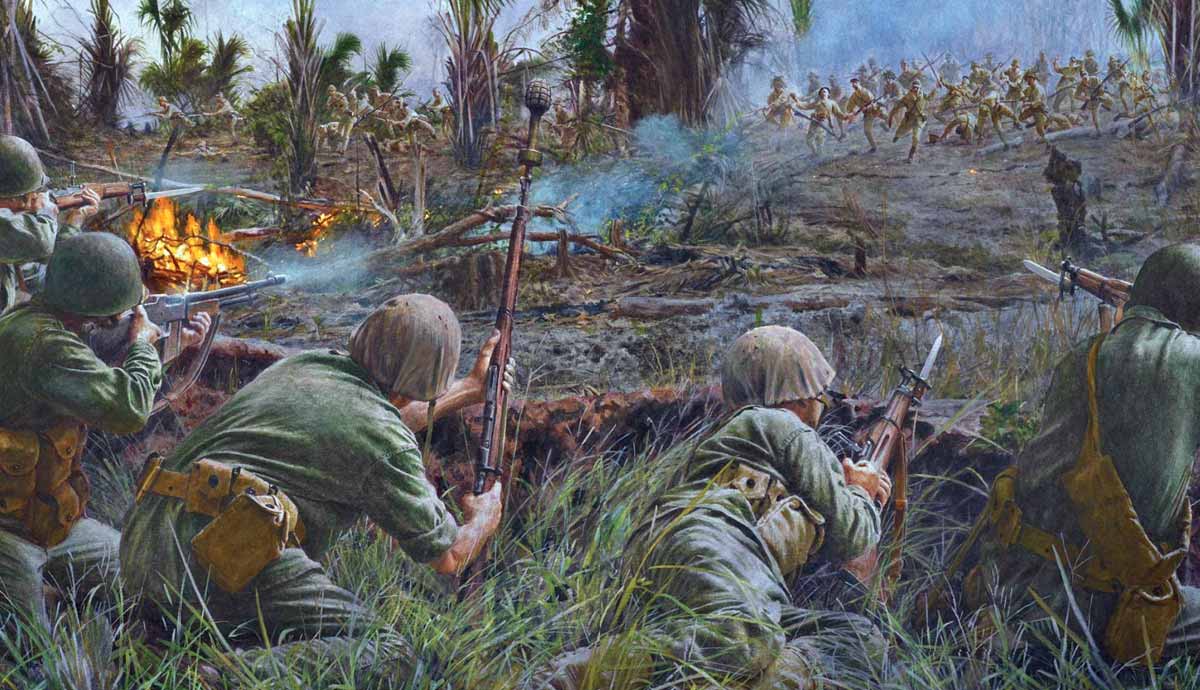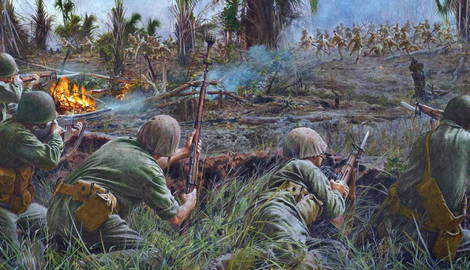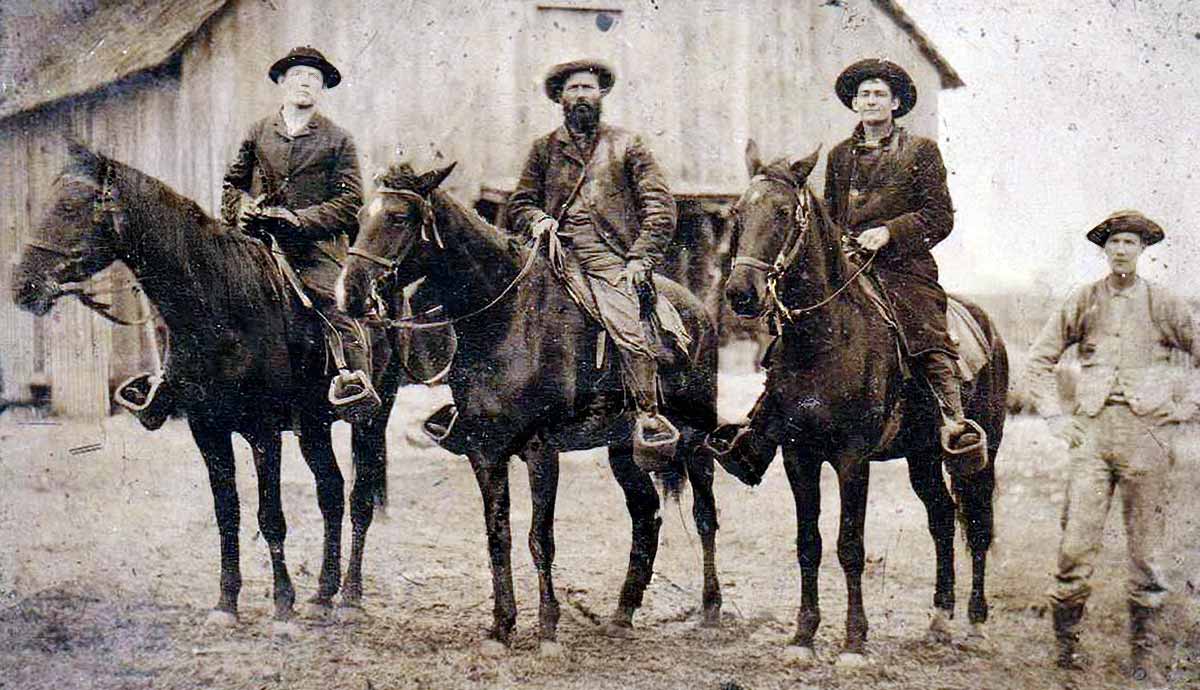
The Battle of Guadalcanal began with U.S. Marines landing on the island of Guadalcanal on August 7, 1942. The Japanese reacted swiftly, starting a vicious months-long air, land, and naval campaign that lasted until February 1943. The U.S. invaded Guadalcanal to stop further Japanese expansion. Japanese plans included an airfield to attack Australian-bound convoys. The island provided a base for future offensive operations south towards Fiji or other locations.
Setting the Stage

Japan’s South Pacific situation looked solid before the battle. Despite severe losses from the Coral Sea and Midway battles, airfields were established across the region, the southernmost being Guadalcanal. The advance on Australia continued. America’s situation proved much shakier as the Imperial Navy controlled the area. But supply lines with Australia were vital. Feeling confident after the Battle of Midway a month before, the U.S. risked an assault on Guadalcanal, which sat astride the shipping lanes.
The Marines Have Landed: August 1942

On August 7, 1942, 11,000 Marines landed on Guadalcanal, Tulagi, and other local islands, taking the big island’s unfinished airfield. Stunned by the landing, the local Japanese troops resisted but soon retreated, leaving behind construction equipment to finish the airfield. Tulagi’s garrison fought to the last man. The Marines built a six-mile-long by three-mile-deep bridgehead and waited.
The Japanese responded with airstrikes on the now-named Henderson Airfield, Tulagi, and on ships. On August 8, at the first Battle of Savo Island, the Imperial Navy sank four Allied heavy cruisers in a night attack. The U.S. Navy pulled back, fearful of attacks damaging their two remaining carriers. At the campaign’s February 1943 conclusion, each side had lost twenty-four ships, from battleships to destroyers, so much so that the Americans named the local waters Ironbottom Sound. The Japanese rapidly transferred troops from other bases and the Philippines.
Henderson Field: August to December 1942

The Henderson airfield, named for a deceased Marine pilot, deserves its own mention. Several factors made the airfield crucial to the battle. First, preventing Imperial Japan from using the airfield was the initial reason. Two, Henderson became an unsinkable aircraft carrier, able to carry out strikes or interceptions during the day with at least nine Marine, Army, and Navy squadrons. Due to American airpower, the Japanese resorted to fast destroyers to move supplies. However, the airfield became the target for all Japanese raids.
From August to December, constant air battles raged over Henderson, intermingled with bombing raids. At night, Imperial Navy ships snuck in to shell the airfield. Two battleships, the Haruna and Kongo, fired 989 fourteen-inch shells at Henderson on October 11 and 12. The Imperial Army also launched three significant attacks, all futile, with hundreds of casualties. The fighting around Henderson Field was as deadly as any in World War II.
The Clash of Giants: November 1942

Like heavyweight boxers, the U.S. and Imperial Navies danced nightly around the waters of Guadalcanal. Though their day was over, both flung huge battlewagons into the melee. The Japanese tried to get desperately needed food to their starving troops. The U.S. sought to deny that and protect its forces.
In one of the last battleships-only fights, the South Dakota and Washington tangled with the Japanese Kirishima on November 12th and 13th. The South Dakota, damaged by the Kirishima, fell away, leaving Washington to fire point blank and sinking the Imperial Navy battleship.
Japanese nightly supply runs dubbed “The Tokyo Express”, using fast destroyers, suffered heavy losses. During the day, American planes dominated the skies, sinking any ship discovered. Soon, submarines took over but only carried enough supplies for the next day. At least three large convoys were pulverized by airpower trying to sneak into northern Guadalcanal.
Jungle Conflicts: 1942-1943

Famous Guadalcanal fights include the Battles of the Tenaru, Henderson Field, and Bloody Ridge. The Marines and U.S. Army brutally fought off tough Japanese attacks. The Japanese could not replace or sustain their troops. The jungle was everyone’s enemy with nasty diseases like mosquito-borne malaria, dysentery, and jungle rot.
In January 1943, Imperial Japan decided to evacuate Guadalcanal. Staggering, irreplaceable losses in aircraft and ship losses swayed the decision. And with no control of the seas, Imperial Army troops began to starve and could not fight. In a clever but risky effort called Operation Ke, the Imperial Navy used fast destroyers to evacuate their forces with few losses. By February 9, 1943, no Japanese remained on Guadalcanal.
Japan’s painful defeat at Guadalcanal checked further expansion. Future battles were all defensive, consolidating their previous gains. With America’s industrial might coming online, the attrition battle began, which Japan couldn’t match.










